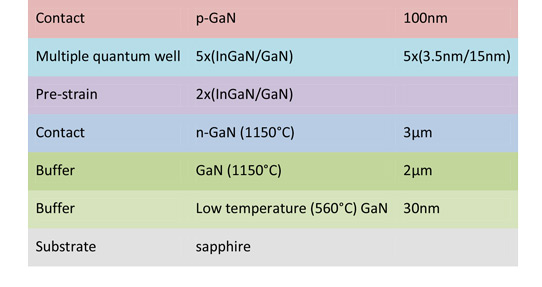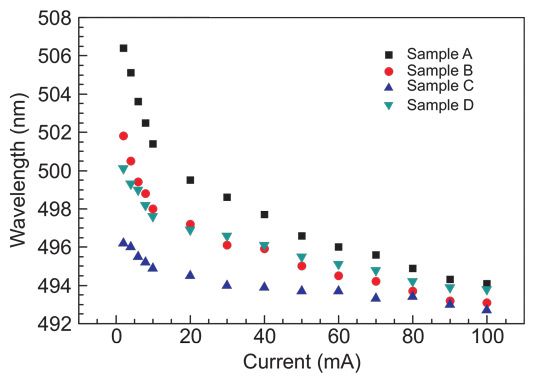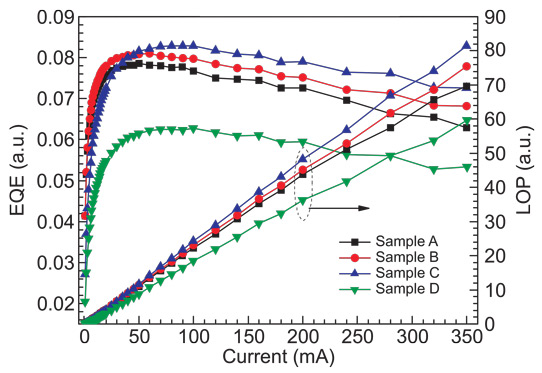- News
17 September 2013
Doped barriers reduce polarization and droop effects in blue-green LEDs
The Chinese Academy of Sciences’ Research and Development Center for Semiconductor Lighting has been exploring the effect of p-type doping of the barriers in multiple quantum well blue-green (~500nm) light-emitting diode (LED) structures [Zhang Ning et al, Chin. Phys. Lett., vol30, p087101, 2013].
Producing green light (> 520nm) from indium gallium nitride (InGaN) compound semiconductor material is difficult to achieve efficiently. Filling the green gap between the efficient orange and blue devices of, respectively, phosphide- and nitride-based semiconductors is the goal of much research.
The Chinese research team found that doping the barriers screens the electric field that arises from the polarization fields that occur due to the highly ionic nature of the III-nitride bond. The electric field tends to pull electrons and holes apart, reducing the amount of recombination as photons. As a result of screening these fields, the efficiency droop effect is reduced without impacting the peak performance.
The LED structures (Figure 1) were grown on c-plane sapphire using metal-organic chemical vapor deposition (MOCVD). The silicon n-type and the magnesium (Mg) p-type doping concentrations of the contact layers were both 5x1019/cm3. The Mg-doping concentration of the multiple quantum well (MQW) barriers was varied according to: 0, 2x1019/cm3, 5x1019/cm3, and 8x1019/cm3, labeled respectively as A-D.

Figure 1: Epitaxial structures of LEDs.
The materials were formed into 580μm x 250μm mesa-structure LEDs with indium tin oxide (ITO) transparent conductor on the p-contact, and chromium/gold electrodes on both the n- and p-contacts.
Measurements of photocurrent under external reverse bias and illumination by monochromatic light from a 10mW/cm2 halogen lamp suggested that doping the MQW barriers screened the electric field arising from polarization.
At 20mA, the electroluminescence peak wavelength (Figure 2) got successively shorter (‘blue-shift’) with increased doping up to sample C (503.2nm for sample A, 494.5nm for sample C). However, the most highly doped sample D had a peak red-shifted by 3.5nm relative to that of sample C. The peaks also blue-shifted with current increasing from 2mA to 100mA: 12.3nm for A, 8.7nm for B, 3.5nm for C, and 6.3nm for D.

Figure 2: Electroluminescence peak wavelengths with different injection currents for all four samples.
The researchers suggest that the screening arises from holes in the barriers migrating to the wells, leaving ionized impurities that partially screen the polarization-dependent electric fields. The blue-shifting effects are explained as being due to the reduced fields leading to an increased effective gap of the wells. The researchers believe that the reverse in the blue-shift trend for sample D is due to the formation of Mg-related defects that decrease the ionization ratio.
The reduced polarization of sample C also improves the light output power and external quantum efficiency (EQE) performance up to 350mA over that of the other devices (Figure 3).

Figure 3: EQE and light output power (LOP) as a function of the current density for all four samples.
Often, reduced efficiency droop is paid for by reduced peak efficiency. However, LEDs of sample C have a peak EQE of 8.3%, while sample A gives 7.85%, B gives 8.05%, and D gives 6.25%.
The droop at 350mA from the peak value was 12.4% for sample C. This compared with 19.9%, 15.7%, and 14.8%, for samples A, B, and D, respectively.
Also the droop sets in later for sample C, being “insignificant” up to 100mA, compared with sample A where the droop begins at around 50mA.
InGaN Blue-green LEDs LED droop MOCVD
http://iopscience.iop.org/0256-307X/30/8/087101
The author Mike Cooke is a freelance technology journalist who has worked in the semiconductor and advanced technology sectors since 1997.





